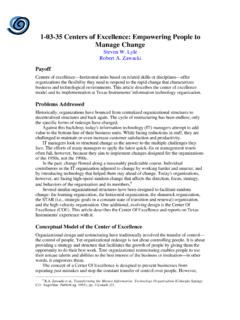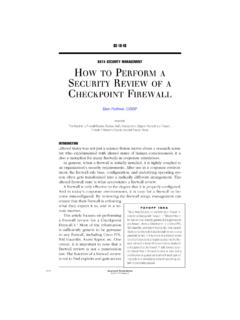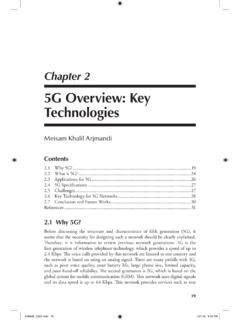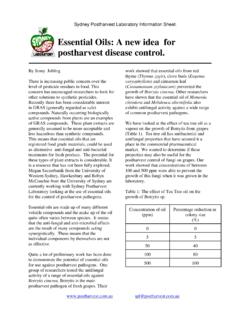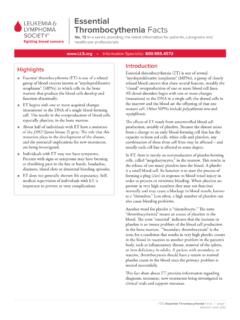Transcription of Information Security Policies, Procedures, and Standards ...
1 82-10-85. DATA Security MANAGEMENT. Information Security . policies , procedures , AND Standards : ESTABLISHING AN. ESSENTIAL CODE OF. CONDUCT. Chris Hare, CISSP. INSIDE. policies and procedures ; The Impact of Organizational Culture; The History of Security Policy;. Why Do We Need Policy?; Management Responsibilities; Planning for Policy;. The Policy Management Hierarchy; The Types of Policy; Writing Policy; Defining Standards ;. Defining procedures ; Defining Guidelines; Publishing the Policy; Establishing a Common Format;. Using a Common Development Process This chapter introduces the reason why organizations write Security pol- icy. Aside from discussing the structure and format of policies , proce- dures, Standards , and guidelines, this chapter discusses why policies are PAYOFF IDEA.
2 Needed, formal and informal Security Information Security policy establishes what policies , Security models, and a his- management wants done to protect the organiza- tory of Security policy. tion's intellectual property or other Information assets. Standards are used to establish a com- mon and accepted measurement that people will THE IMPACT OF ORGANIZATIONAL CULTURE use to implement this policy. procedures provide the details the how of the implementation, The culture of an organization is very while guidelines identify the things that manage- important when considering the de- ment would like to see implemented. Policy is an velopment of policy. The workplace essential and important part of any organization is more than just a place where peo- because it identifies how the members of that or- ple work.
3 It is a place where people ganization must conduct themselves. To the in- formation Security manager, policy establishes congregate to not only perform their what is important to the organization and what de- fines the shape of the work that follows. 10/01 Auerbach Publications 2001 CRC Press LLC. assigned work, but to socialize and freely exchange ideas about their jobs and their lives. It is important to consider this culture when developing policies . The more open an organization is, the less likely that policies with heavy sanctions will be accepted by the employees. If the culture is more closed, meaning that there is less communication between the employ- ees about their concerns, policies may require a higher degree of sanc- tions. In addition, the tone, or focus, of the policy will vary from softer to harder.
4 Regardless of the level of communication, few organizations have their day-to-day operations precisely documented. This highly volatile environment poses challenges to the definition of policy, but it is even more essential to good Security operations. THE HISTORY OF Security POLICY. Security policy is defined as the set of practices that regulate how an or- ganization manages, protects, and assigns resources to achieve its secu- rity objectives. These Security objectives must be tempered with the organization's goals and situation, and determine how the organization will apply its Security objectives. This combination of the organization's goals and Security objectives underlie the management controls that are applied in nearly all business practices to reduce the risks associated with fraud and human error.
5 Security policies have evolved gradually and are based on a set of se- curity principles. While these principles themselves are not necessarily technical, they do have implications for the technologies that are used to translate the policy into automated systems. Security Models Security policy is a decision made by management. In some situations, that Security policy is based on a Security model. A Security model de- fines a method for implementing policy and technology. The model is typically a mathematical model that has been validated over time. From this mathematical model, a policy is developed. When a model is creat- ed, it is called an informal Security model. When the model has been mathematically validated, it becomes a formal model. The mathematics associated with the validation of the model is beyond the scope of this chapter, and will not be discussed.
6 Three such formal Security models are the Bell-LaPadula, Biba, and Clark-Wilson Security models. The Bell-LaPadula Model. The Bell-LaPadula, or BLP, model is a confi- dentiality-based model for Information Security . It is an abstract model that has been the basis for some implementations, most notably the Department of Defense (DoD) Orange Book. The model defines the no- 10/01 Auerbach Publications 2001 CRC Press LLC. tion of a secure state, with a specific transition function that moves the system from one Security state to another. The model defines a funda- mental mode of access with regard to read and write, and how subjects are given access to objects. The secure state is where only permitted access modes, subject to ob- ject are available, in accordance with a set Security policy.
7 In this state, there is the notion of preserving Security . This means that if the system is in a secure state, then the application of new rules will move the system to another secure state. This is important, as the system will move from one secure state to another. The BLP model identifies access to an object based on the clearance level associated with both the subject and the object, and then only for read-only, read-write, or write-only access. The model bases access on two main properties. The simple Security property, or ss-property, is for read access. It states that an object cannot read material that is classified higher than the subject. This is called no read up. The second property is called the star property, or *-property, and relates to write access. The subject can only write Information to an object that is at the same or higher classification.
8 This is called no-write-down or the confinement property. In this way, a subject can be prevented from copying informa- tion from one classification to a lower classification. While this is a good thing, it is also very restrictive. There is no dis- cernment made of the entire object or some portion of it. Neither is it possible in the model itself to change the classification (read as down- grade) of an object. The BLP model is a discretionary Security model as the subject defines what the particular mode of access is for a given object. The Biba Model. Biba was the first attempt at an integrity model. Integ- rity models are generally in conflict with the confidentiality models be- cause it is not easy to balance the two. The Biba mode has not been used very much because it does not directly relate to a real-world secu- rity policy.
9 The Biba model is based on a hierarchical lattice of integrity levels, the elements of which are a set of subjects (which are active Information pro- cessing) and a set of passive Information repository objects. The purpose of the Biba model is to address the first goal of integrity: to prevent un- authorized users from making modifications to the Information . The Biba model is the mathematical dual of BLP. Just as reading a low- er level can result in the loss of confidentiality for the Information , read- ing a lower level in the integrity model can result in the integrity of the higher level being reduced. Similar to the BLP model, Biba makes use of the ss-property and the *-property, and adds a third one. The ss-property states that a subject can- not access/observe/read an object of lesser integrity.
10 The *-property 10/01 Auerbach Publications 2001 CRC Press LLC. states that a subject cannot modify/write-to an object with higher integri- ty. The third property is the invocation property. This property states that a subject cannot send messages ( , logical requests for service) to an object of higher integrity. The Clark-Wilson Model. Unlike Biba, the Clark-Wilson model addresses all three integrity goals: preventing unauthorized users from making modifications maintaining internal and external consistency preventing authorized users from making improper modifications Note: Internal consistency means that the program operates exactly as ex- pected every time it is executed. External consistency means that the pro- gram data is consistent with the real-world data. The Clark-Wilson model relies on the well-formed transaction.



